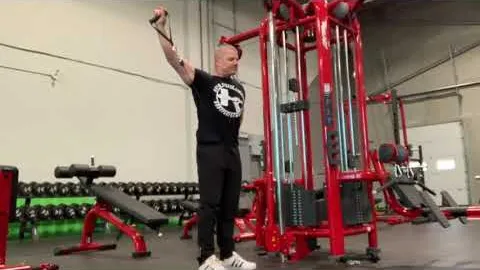




One of the most effective exercises for targeting the medial deltoid, or the middle portion of the shoulder, is the Cable One Arm Side Lateral Raise. This exercise not only helps to build strong and rounded shoulders, but it also improves shoulder stability and enhances overall upper body strength. In this comprehensive guide, we will take a closer look at the Cable One Arm Side Lateral Raise, its benefits, proper technique, variations, and common mistakes to avoid.
The Cable One Arm Side Lateral Raise offers numerous benefits for individuals of all fitness levels. Here are some of the advantages it provides:
Targeted Shoulder Development: The main focus of this exercise is the medial deltoid, which plays a crucial role in shoulder width and aesthetics. By isolating and targeting this muscle group, the Cable One Arm Side Lateral Raise helps to enhance shoulder development and create a well-rounded physique.
Improved Shoulder Stability: As a single-arm exercise, the Cable One Arm Side Lateral Raise engages the stabilizer muscles in the shoulder, promoting better shoulder stability and preventing common imbalances. This can be especially beneficial for athletes involved in sports that require overhead movements, such as tennis, swimming, and baseball.
Enhanced Upper Body Strength: Engaging the deltoids, trapezius, and upper back muscles, the Cable One Arm Side Lateral Raise contributes to overall upper body strength development. Strengthening these muscles not only improves shoulder aesthetics but also enhances performance in various upper body movements and exercises.
Versatility and Adjustable Resistance: Cable machines provide adjustable weight resistance, allowing individuals of all fitness levels to perform the Cable One Arm Side Lateral Raise. Whether you are a beginner or an advanced lifter, you can easily adjust the weight to suit your strength and gradually increase the load as you progress.
To fully benefit from the Cable One Arm Side Lateral Raise and avoid potential injuries, it is essential to perform the exercise with proper form and technique. Follow these steps:
Set Up: Begin by standing beside a cable machine with your feet shoulder-width apart. Adjust the cable pulley to the lowest position and attach a D-handle to the cable. Grasp the handle with your palm facing your body and take a step away from the machine to create tension in the cable. Position your feet and body to stabilize yourself.
Starting Position: Hold the handle with your arm fully extended, keeping a slight bend in your elbow. Stand tall with your shoulders relaxed, chest up, and core engaged. This is your starting position.
Execution: Initiate the movement by raising your arm to the side, ensuring that your elbow remains slightly bent throughout the exercise. Focus on isolating the medial deltoid as you lift the weight, leading with your elbow. Continue raising your arm until it reaches shoulder height, keeping your wrist neutral and your forearm parallel to the ground.
Peak Contraction and Control: At the top of the movement, pause for a brief moment and squeeze your deltoid muscles to maximize the contraction. Slowly lower the weight back to the starting position, maintaining control throughout the descent. Avoid any swinging or jerking motions that may compromise the effectiveness of the exercise.
Repeat: Complete the desired number of repetitions before switching sides and performing the exercise with the other arm.
Once you have mastered the basic Cable One Arm Side Lateral Raise, you can incorporate variations and progressions into your routine to keep challenging your muscles and promoting further growth. Here are some options to consider:
Cable Side Lateral Raise with a Twist: Instead of raising your arm directly to the side, add a slight rotation at the end of the movement. This variation targets additional shoulder muscles and increases the overall difficulty of the exercise.
Cable One Arm Front Raise: This exercise focuses on the anterior deltoids and can be performed with the same cable setup, but with the arm lifted forward instead of to the side. It provides a balanced approach to shoulder development.
Increased Resistance and Repetitions: As your strength and technique improve, progressively increase the resistance by adding weight to the cable machine. Additionally, you can increase the number of repetitions or sets to further challenge your muscles and stimulate growth.
To get the best results from the Cable One Arm Side Lateral Raise, it is crucial to avoid common mistakes that can hinder your progress or lead to injury. Here are some mistakes to be mindful of:
Using Too Much Weight: Selecting a weight that is too heavy can compromise your form and lead to unwanted stress on your joints. Start with a weight that allows you to maintain proper technique and gradually increase the resistance as you become more comfortable with the exercise.
Poor Range of Motion: Failing to raise your arm to shoulder height limits the effectiveness of the exercise. Focus on achieving a full range of motion while keeping your deltoids engaged throughout the movement.
Leaning or Twisting: Avoid leaning your torso or twisting your body during the exercise. This can take the emphasis off the targeted muscle groups and increase the risk of injury. Maintain a stable and upright position throughout the movement.
Lack of Control: Swinging or jerking the weight up and down reduces the effectiveness of the exercise and increases the risk of straining your muscles. Always prioritize control and perform the movement in a slow and controlled manner.
The Cable One Arm Side Lateral Raise is an exceptional exercise for developing strong and well-rounded shoulders. By incorporating this exercise into your upper body training routine, you can enhance your shoulder strength, stability, and overall aesthetics. Remember to execute the exercise with proper form, explore variations and progressions, and avoid common mistakes for optimal results. Start incorporating the Cable One Arm Side Lateral Raise into your workouts, and experience the benefits it has to offer.
If you're looking for a gym, fitness club or yoga studio, you've come to the right place.
You can find information about gyms in your area. Browse catalog of gyms and find gyms with classes which are you looking for.
On gym page you can find simple information like address, phone or website. You can find list of available classes. You can check availability of personal training or small group classes. On place page you can also see information about open hours.
You can find gyms near you with amenities, courts, studios and equipments.
Use our map to find gym at your city or district.
In Gym Navigator you can find list of exercises with movies for many body parts.
You can browse exercises catalog and find exercises the best of you.
You can also find exercises grouped into workout plans, which you can use to improve you body. Each routine show you exercises one by one and give you possibility to count you progress and count down rest time.